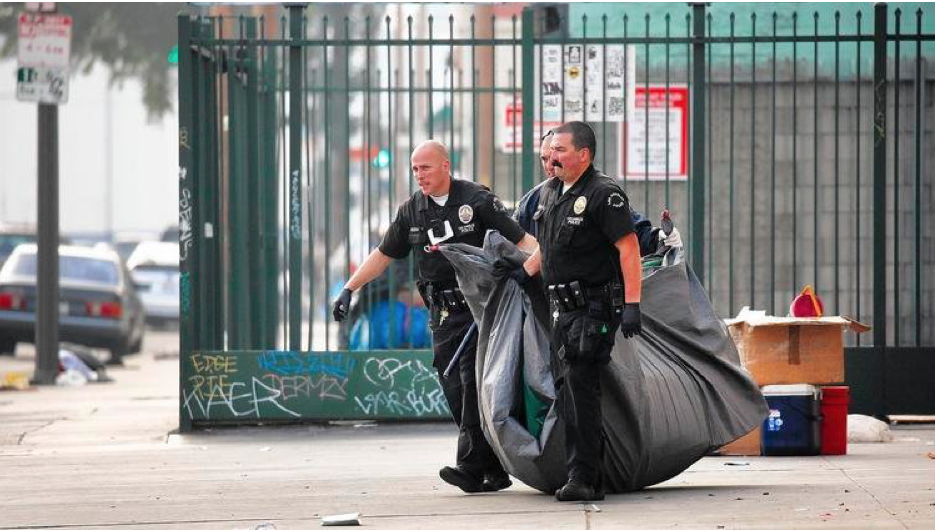CommentsVOICES--Once upon a time, in a town at the far end of the city, stakeholders actually got what their taxes paid for, and lived in a place that had very few homeless, vagrants and drug dealers.
Fast forward- this tiny town, known as San Pedro, is currently overrun with homeless, mentally ill, drug addicts and early release felons. Police make fewer and fewer arrests because their hands are tied by the likes of Carol Sobel, attorney advocate for the homeless, our Mayor, and our State government. Disgruntled homeowners look to fellow stakeholders like George Matthews and Chris Balonek to help clean up the encampment trash that threaten to take over the streets, and chase down criminals, quietly assisting police by locating and videoing crimes in progress.
Discouraged by streets riddled with the walking dead, human refuse, drug paraphernalia, and piles of trash and garbage, San Pedro has come to a crisis point. Like other places in Los Angeles, whenever a solution is offered, there is a reason not to want it in the local community. But there DO have to be solutions, out of the box, creative solutions.
Currently, each CD is being asked to come up with at least one location for either a Navigation Center, Bridge Housing or Safe Vehicle Dwelling Parking Lot. What could possibly go wrong? CD15 apparently had 25 locations on its original list and have come down to 3. However, each location has a set of issues to be dealt with.
Firstly, each location is supposed to be City property. The locations in Wilmington and San Pedro belong to the Port and the State of California, respectively. Secondly, each location would normally be required to have an EIR. However, since the passage of AB932, the usual safety standards and building code requirements have been waived for cities like San Francisco and Los Angeles. (Interesting side-note- Los Angeles, being a charter city, doesn’t have to abide by its own charter, like the citizens do.)
Most of the money allotted to developing the locations into a “habitable” space will be going into infrastructure- fencing, water, sewage, electricity, porta-potties, portable showers, etc. So far, the security has not been figured out. Will it be LAPD or hired security? Armed or the grocery store “security monitor” kind? Will neighborhoods surrounding these centers have additional patrols?
Sanitation has not been figured out- according to the reps from Sanitation it will be done on a formula- the formula is not yet figured out. LAHSA’s formula for 1 porta potty and shower per 20 people, seems to be a health hazard if not cleaned several times each week. Which Sanitation says will not happen. Promises made but frequently broken make stakeholders wary of believing what they are promised. And, in reality, what are taxpayers getting for their money here? It has been said that the cost to house each homeless person is about $125,000. Think about that for a minute! What to do? What to do?
Glad you asked! An anonymous tip was passed to me to research something called the McKinney-Vento Act. The McKinney-Vento Act, passed by the 100thCongress in 1987, is the only fully funded Federal homeless housing act ever passed. And it was later amended to provide more funds where children are impacted by homelessness.
It also states that unused, excess and abandoned Federal property, including military bases, can be used for homeless housing. That is a WIN! There is a large amount of abandoned Federal and military land on Terminal Island, some with beautiful buildings already on site. With some retrofitting, using those government funds, these sites could be a great solution. WIN AGAIN! But it doesn’t stop there! The solution gets even better! Two of the buildings- a Navy Commissary and the old Federal Building, are great locations for housing, services, cafeterias, and more. The Commissary has space for a community garden.
Just down the street from the Federal Building is a piece of lost history- an old WW2 airstrip. Before WW2 it was called Allen Field, then changed to Reeves Field. Women Airforce Service Pilots (WASPs) delivered new military planes there and taught young male pilots how to do water landings. This strip sits abandoned, waiting to be refurbished and developed into an historical location. Creating such an historical location could be an opportunity for jobs for the homeless being housed, first in developing the site as a tourist location, and then as docents and shop managers for the completed project. Creating jobs that have pride of ownership gives more meaning than a job that is just a placeholder. WIN #3! What about transportation, you say? Why not include a shuttle service through the funding to transport new residents of the housing to appointments?
This again, leaves the mentally ill, drug addicted and criminal element on San Pedro streets. At this point, because those who WANT to be housed have been housed, SB5611 can be enforced, untying the hands of the police somewhat, and giving residents an opportunity to enjoy their community with less fear of being unpleasantly confronted everywhere they go.
Why hasn’t our Mayor and City council made use of the McKinney-Vento Act? Why are the taxpayers being dunned for more money at every turn when there is money available already? It appears that either they are not doing their homework or that perhaps there is nothing that might benefit them or the friends who get the contracts for building the new housing, which is already having budget overruns. It at least gives one pause to wonder why this has not even been mentioned?
(Gayle Fleury is a community activist and lives in San Pedro.)
-cw
















